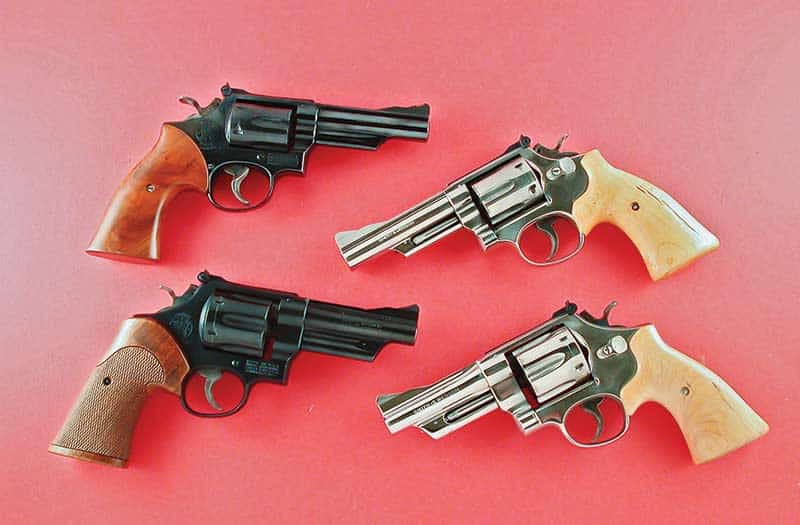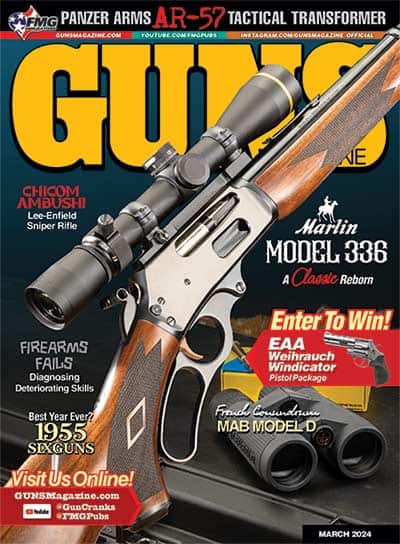1955: A Classic Age Of Sixguns
Part I — S&W
“There must’ve been something in the water!” “The planets must have been lined up just right.” These are clichés we often hear when something special happens. The truth is there’s nothing in the water to make things special and certainly, the planet alignment has nothing to do with anything. However, there are some years when it comes to sixguns that definitely stand out.
The year 1955 was outstanding in many ways. I became a senior in high school, Gunsmoke and the Mickey Mouse Club debuted on television, McDonald’s opened their first restaurant, Disneyland opened, one of the top songs was Rock Around The Clock, Sugar Ray Robinson regained the middleweight championship and the Dodgers beat the Yankees 4-3 in the World Series. However, the most important things came from Colt, Smith & Wesson and Ruger. In fact, from my perspective, 1955 is at the top of the list when it comes to the Golden Age of Sixguns.
1955 TARGET MODEL (April 1955): Top-notch gunsmith and highly successful bull’s-eye shooter Jimmy Clark was directly responsible for the 1955 Target Model. In 1949, Jimmy did a short action-job on a model 1917 S&W .45 ACP revolver. He had found he could shoot the revolver better than the 1911s available at the time.
In 1951 Jimmy bought two S&W 1950 Target .45 ACP revolvers, tuned the actions and found he had a revolver which would shoot jacketed bullets pretty well but as he says, “… they were a disaster with our handload using the Hensley & Gibbs #130 cast bullet and 3.5 grains of Bullseye powder. I returned both revolvers to the factory explaining the problem. After several months, I received them back with very small groups the boys at the factory claimed to be fired at 50 yards. I again tried various loads with the same terrible results. The guns were retired and never fired again.”
In 1954 Jimmy was complaining to someone at S&W not knowing he was talking to then S&W President Carl Hellstrom about those 1950 Target sixguns. The discussion became quite heated and the president did not at first appreciate what Jimmy had to say.
Jimmy thought that would be the end of it but the more Hellstrom thought about it, the more he felt Jimmy knew what he was talking about. The following year, 1955, Jimmy won the Mid-Winter Matches and he was awarded a brand-new S&W 1955 Target. When Hellstrom presented the award he said, “You of all people winning one of these guns.” Jimmy once again told him he had purchased the 1950 Target to shoot, and they would not; if this one would, he would use it. With its heavier barrel cut especially for cast bullets, Jimmy found it shot every bit as good as the 1911 autos.
.357 COMBAT MAGNUM (December 1955): Bill Jordan — Marine combat veteran and Border Patrol Chief Inspector when he retired in 1965 — was directly responsible for the .357 Combat Magnum. In 1986 Bill spoke of how the Combat Magnum came about: “In 1950, S&W introduced the Model 15, a 4″-barreled version of its K-Frame Masterpiece series. The only thing wrong was it was a bit too light, especially the barrel for defense use, and was chambered for the .38 Special cartridge. They called the new gun the Combat Masterpiece.
Following the Masterpiece debut, I had given a lot of thought to advantages from chambering the Combat version for the .357 Magnum cartridge. Possibly it could have been done by simply boring out the cylinder the required 1/8″, but that was an operation that looked mighty dangerous to me and one I wasn’t about to experiment with. Early reports of the Magnum’s awesome power were too fresh in my mind. Even so, I had dreamed of the gun I would like to have in my Christmas stocking and the idea of that K-Frame wedded to the more powerful cartridge had stayed with me.”
Jordan discussed the idea of the lighter .357 Magnum with Carl Hellstrom and Hellstrom discussed the feasibility of the idea with his engineers. On November 15, 1955, the first production medium-frame Magnum was completed; it was serial number K260,003. This new gun was named the Model 19 Combat Magnum. When the lowest serial number gun in this first production run (K260,001) was complete, it was forwarded to Bill Jordan. Since the date of its introduction, the Combat Magnum/Model 19 had been one of S&W’s most popular handguns.
.44 MAGNUM (December 1955): By 1950, the .44 Special chambered in an S&W sixgun reached its climax with the superb 1950 Target Model. Since 1907, S&W and later Colt, provided .44 Special sixguns but it remained for men, like members of The .44 Associates, to bring out the best of the .44 Special cartridge. From the 1920s to the 1950s, associate members, most notably Elmer Keith, called for a “real .44 Special” load.
He especially called for a “.44 Special Magnum” with a 250-grain hard-cast bullet at 1,200 feet per second. His pleas seemed to fall on deaf ears. Ammunition companies were afraid of heavy loaded .44 Specials taking old sixguns apart. He then asked for a new cartridge 1/10 of an inch longer than the .44 Special to preclude its being used in any old sixguns — and also a new sixgun chambered for the new cartridge. Again, the plea was ignored.
Unbeknownst to him, S&W started to listen. Working in tandem with Remington, supplier of the new .44 Magnum ammunition, Smith engineers went to work on the new sixgun. In 1954, Remington gave S&W the dimensions of a new cartridge 1/8″ longer than the .44 Special. S&W then chambered four specially heat-treated 1950 Target .44 Special sixguns for the new “.44 Magnum.” The guns performed well but at the 39-oz. weight of the 1950 Target, recoil was brutal with a 240-grain bullet at 1,500 fps.
Weight had to be added, so the cylinder was lengthened to fill in the cylinder window and the 6 ½” slim barrel was changed to a heavyweight full bull-barrel style as found on the 1955 Target .45 ACP, resulting in a weight of 48 oz. In December of 1955, S&W called Elmer Keith to tell him his dream had come true. Others may claim they were responsible for the .44 Magnum, and Elmer did not invent it, but he certainly is the number one man in urging its development.





